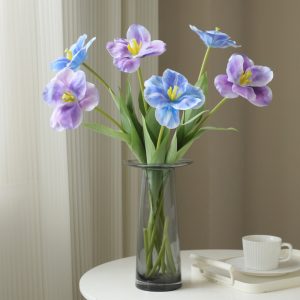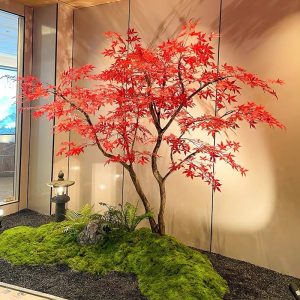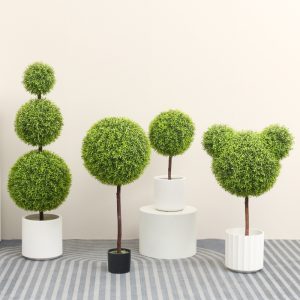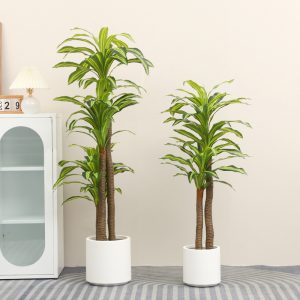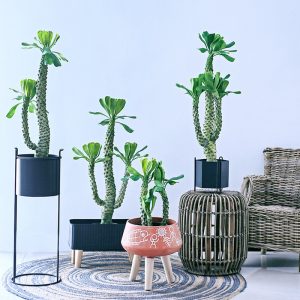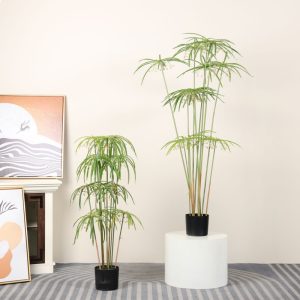Having worked in the artificial plant industry for many years, the most frequent question I get asked every day is: “Should I buy artificial plants, or should I go for real ones?” Honestly, there’s no standard answer to this. However, based on market feedback and experience, I can help you make the best decision based on your needs and circumstances. Today, I will break down the comparison into “cost, effort, longevity, and placement” to help you make the most suitable choice for your space.
1. Comparing “Care Costs”: Time and Money Both Matter
Real Plants: Money and Time Required, With a Higher Risk of “Failure”
- Time Investment: According to the American Horticultural Society, an average indoor plant (such as a pothos) requires 1-2 hours per week (watering, fertilizing, pruning, pest control). Over the course of a year, that’s about 80+ hours spent just caring for plants. If you have a dozen plants at home, you might be looking at 5 hours a week.
- Money Spent: Although purchasing a single plant is not very expensive (typically $10-$30), the ongoing costs add up: nutrients ($20-$50 annually), repotting ($30-$80 annually), pesticides and fungicides ($15-$40 annually). Even worse, the mortality rate for new plant owners is as high as 65%, meaning you may end up spending on two plants just to get one that survives.
Artificial Plants: One-Time Investment, Low Maintenance
- Time: It requires almost no time—just 5 minutes a week for basic upkeep, totaling about 5 hours a year, which is only 1/16th of the time required for real plants. Even large artificial plant walls only need cleaning once a month, which takes about 1 hour.
- Money: While the initial cost of an artificial plant may be higher ($30-$100), the subsequent costs are minimal—about $5 annually for cleaning supplies. The key advantage is that artificial plants can last 3-5 years or longer. Over 5 years, the average annual cost is only $6-$20, while real plants would cost $25-$60.
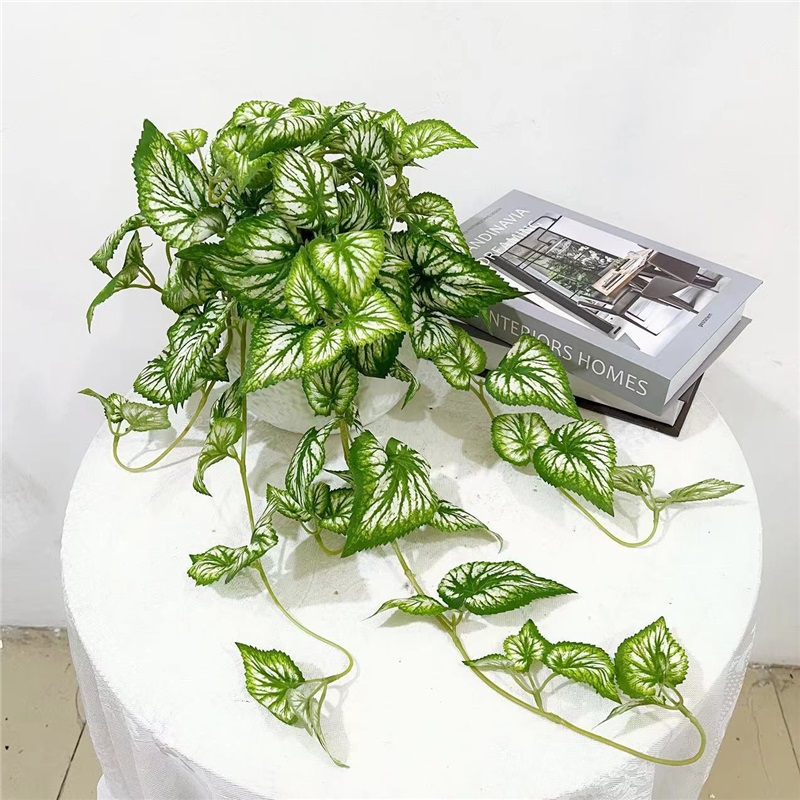
2. Comparing “Survival Ability”: Where Can They Live Without Dying or Wilting?
Real Plants’ “Weak Spots”:
- Low Light Areas: Places like north-facing rooms, basements (light <500lux), etc., where 90% of foliage plants can’t survive for more than 3 months without turning yellow or becoming leggy.
- Places with Temperature Fluctuations: Locations near air conditioning vents (constant temperature shifts) or radiators (dry environments) usually kill real plants within a month.
- High Traffic Areas: In places like malls, children’s rooms, or pet areas, real plants suffer from wear and tear at 8 times the rate of artificial plants.
Artificial Plants’ “Domains”:
- Low-Maintenance Areas: Such as homes with frequent travel, offices with no regular care, or high-end hotel lobbies where aesthetics must be maintained. Artificial plants look vibrant 99% of the time, no matter what.
- Special Environments: Places like direct sunlight behind glass, exposed balconies with strong winds, or underwater landscapes where real plants typically fail, but artificial plants can thrive.
- Creative Spaces: If you want a plant wall, real plants need complex watering systems and are prone to malfunctions. Artificial plants are perfect for this kind of creative design.
3. Comparing “Aesthetic Appeal”: Who Can Stay Beautiful Longer?
Real Plants’ “Variability”:
- Seasonal Changes: Deciduous plants lose their leaves in winter, and flowering plants may only look beautiful for a few weeks each year, leaving them unattractive for the rest of the time.
- Prone to Growing Awkwardly: Even with careful care, plants might grow unevenly due to improper light or pruning. Real plants need constant trimming and adjustments to maintain a pleasing shape.
- Pest and Disease Issues: Red spider mites, powdery mildew, and other issues can cause leaves to look sickly, and the chemicals used to treat them can also be unpleasant.
Artificial Plants’ “Stable Beauty”:
- Consistent Beauty Year-Round: High-quality artificial plants retain their most beautiful moment (like a blooming rose or shiny monstera leaf) throughout the year, and the color only fades by less than 5% annually.
- Fixed Shape: Once designed, artificial plants will not change their shape due to time or environmental changes, making them ideal for places requiring symmetry and beauty (e.g., on either side of a doorway or along a long conference table).
- Customizable Designs: Artificial plants can break natural limits to create the exact look you need. Want a 3-meter-high bird of paradise or blue hydrangeas? No problem.
4. Comparing “Total Cost”: Which One is More Cost-Effective Over 5 Years?
Here’s a detailed cost comparison of real plants and artificial plants over a 5-year period:
- Initial Purchase Cost: Real plants typically cost $10-$30; artificial plants cost $30-$100.
- Maintenance Supplies (Water, Fertilizer, Pesticides): Real plants will require $100-$300 over 5 years; artificial plants only need $25-$50.
- Replacement Costs: Real plants often need to be replaced 2-3 times due to death or aging, costing $50-$150; artificial plants don’t need replacing, so the cost is $0.
- Labor Time: Real plants require 400 hours of care, costing approximately $4000 at $10/hour; artificial plants only need 25 hours, costing about $250.
Total Cost: Over 5 years, real plants cost $560-$4480, while artificial plants only cost $55-$200.
5. Comparing “Environmental Impact”: Which One Is More “Green” in the Long Run?
The Ecological Account of Real Plants: They absorb CO2 and release oxygen, but they require a lot of water (300-500 liters per plant annually), and their transportation, especially plants requiring cold chain shipping, has a much higher carbon footprint—3 times higher than that of artificial plants.
The Sustainability of Artificial Plants: Most high-quality artificial plants are made from recycled plastics (e.g., PET bottles), reducing plastic pollution. More importantly, they last longer and don’t need watering, resulting in significantly lower carbon emissions. Over a 5-year period, the carbon emissions of artificial plants are only 1/5 of those of real plants.
6. Direct Recommendations: How Should Different Groups Choose?
- “I Kill Every Plant” / Busy People: Go for artificial plants! Choose those with “UV protection” coatings, which can safely be placed in sunny spots without fading, freeing up your time and effort.
- “I Love Gardening” Hobbyists: If you truly enjoy taking care of plants, real plants will give you a sense of accomplishment and vitality that cannot be replaced. However, if you want greenery in places where real plants are hard to maintain (e.g., dark corners, near radiators), a few high-quality artificial plants will look great and save you time.
- Business Owners (Hotels, Malls, Offices): Most spaces should use artificial plants. It saves money and time and lowers maintenance costs. Just place a few carefully maintained real plants in key areas (like the reception or VIP lounges) to enhance the overall warmth and appeal.
Final Honest Thoughts: Real plants have a living energy and interacting with them is fun; artificial plants are more hassle-free and maintain their beauty without worry. Which one to choose depends on what you value most. If you’re stuck in deciding for specific situations (e.g., a sunroom or a smoky hotpot restaurant area), feel free to ask in the comments. I will provide tailored advice based on my experience.







